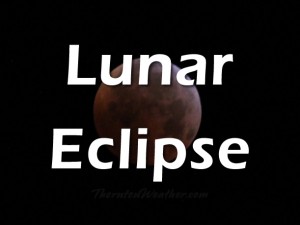
If you can get yourself out of bed early in the morning on Saturday, December 10, 2011 you will be treated to the last total lunar eclipse for nearly three years. For viewers in Thornton and along the Colorado Front Range, the event will be relatively quick but punctuated by a setting moon with the Rocky Mountains in the foreground.
Saturday morning the moon will be passing through the lower half of the Earth’s shadow just before it sets in the west at 7:12am MST Saturday. The low hanging moon will appear much larger than normal bringing what NASA calls a ‘super-sized’ eclipse.
Because the moon will be low on the western horizon, finding a good spot to watch it will be critical. In Thornton, visitors to our Facebook page have suggested near the Thornton Civic Center, Brittany Hill or near the water towers at 112th Ave and I-25. Some higher locations along Colorado Blvd north of 136th Ave might be good places as well.
The December 10th eclipse will begin around 5:46am MST as the first part of Earth’s shadow encroaches on the moon. Totality will be achieved at 7:06am MST.
For watchers along the Colorado Front Range, the low moon with the Rocky Mountains to the west will render some extraordinary images. There is however a catch.
The tall mountains on our western horizon are going to limit the time we are able to see the moon and the eclipse. In the Denver area, we won’t actually be able to see the total eclipse as the moon will have disappeared behind the mountains by then.
It is estimated metro area residents will be able to watch the show until about 6:50am at which point the moon will be below the horizon. Clear skies are in the forecast so clouds should not be a concern.
- Examiner.com slideshow: NASA maps and images for the December 10, 2011 total lunar eclipse
- Stay up to date with ThorntonWeather.com: ‘Like’ us on Facebook, follow us on Twitter and add us to your Google+ circles
NASA says that astronomers and psychologists don’t know why the human brain sees the moon as larger when it is low on the horizon. “In fact, a low Moon is no wider than any other Moon (cameras prove it) but the human brain insists otherwise. To observers in the western USA, therefore, the eclipse will appear super-sized,” NASA said.
The celestial show should be worth getting out of bed a bit early to see, even if residents of Colorado won’t get to see the entire show.
Atmospheric scientist Richard Keen of the University of Colorado told NASA, “I expect this eclipse to be bright orange, or even copper-colored, with a possible hint of turquoise at the edge.”
Keen explains that the Earth’s stratosphere is currently relatively free of volcanic dust and other particulates. This should allow for a very bright event.
Tomorrow’s eclipse will be the last total lunar eclipse until April 14, 2014. A second will occur that year on October 8th. In 2015 there will also be two; one on April 4th and another on September 27th.
If you get any pictures of the eclipse, be sure to head over to our Facebook page and share them or email them to us at info@thorntonweather.com and we will post them.
